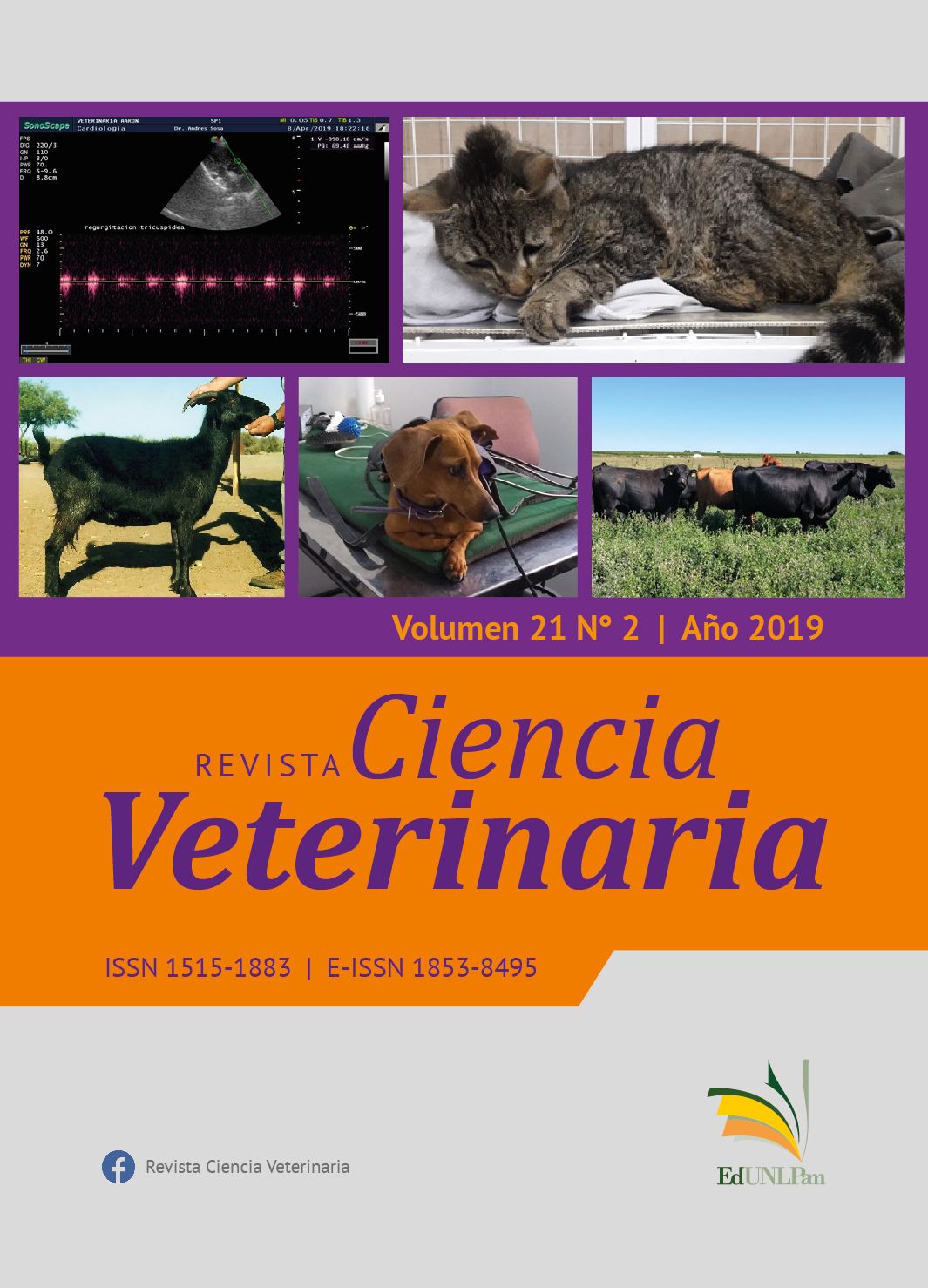Fry growth modelling in Cichlasoma festae (Cichlidae) with Biobloc technology (BFT)
DOI:
https://doi.org/10.19137/cienvet-201921203Keywords:
Conservation, Native species, Technological innovation, Growth modelsAbstract
Aquaculture favors food sovereignty in Equator, maintains their livelihoods and boosts household unit incomes. The freshwater species Cichlasoma festae represents an important species of great local use. In this study, our objective was to model fry growth in Cichlasoma
festae, produced in intensive systems with Biobloc technology. The study lasted 90 days and was carried out in the experimental farm “La María”, in Quevedo Local Technical University (UTEQ). 15 cages were placed inside a reinforced concrete circular pond with Biobloc and 300
fries from C. festae with a weight of 4,9g were introduced. Individual biometric parameters of total length, weight and height were fortnightly measured in 75 fries from C. festae. Physicochemical parameters of Biobloc water (PH, temperature, oxygen, total ammoniacal nitrogen and suspended solids) were daily measured. Growth was determined using regression models and in a second stage the weight was adjusted to the best fit selected model, which was: Log-Y Square root-X which explains the 98,3% of the variability in weight. We may conclude with this study that Biobloc technology could be an alternative for intensive native species production. In future research, it will be necessary to advance in the knowledge of Biobloc conditions for each species, production biomass, aeration strategies for each growth stages and thus boost and optimize farming.
Downloads
References
Rodríguez, J., Vivas, R., Medina, M., González, M., Barrera, A., García, A. (2015). XI Congreso de la Federación Iberoamérica de Razas Criollas y Autóctonas. Zaragoza. España. 12, 217-220.
Rodríguez, J. Caracterización de la Cichlasoma festae (Vieja Colorada) en la cuenca
hidrográfica del Guayas. Ecuador. (2017). Tesis Doctoral de la Universidad de Córdoba.
MAGRAMA, 2011. Diversificación en acuicultura: Una herramienta para la sostenibilidad. Edita la Secretaría General del Mar del Ministerio de Medio Ambiente, Medio Rural y Marino de España. Madrid, España.
Collazos-Lasso LF, Arias-Castellanos JA. (2009). Estimulación a la madura- ción final
y el desove de Ancistrus triradiatus. Orinoquia; 19(1)
Avnimelech, Y. (2006). Control of microbial activity in aquaculture systems: active
suspension ponds Aquacultural engineering, 34(3), 172-178.
Ladino-Orjuela, G. (2011). Dinámica del Carbono en estanques de peces Orinoquia,
(1), 48-61.
Gunter, P. 2010. The Blue Economy. Paradigma de Publicaciones, Taos, Nuevo México.
Lujar y Chimbor. 2019. Bioflocs: Tendencia en la producción acuícola sustentable.
LAQUA 19. San José – Costa Rica. Noviembre 20-22.
Rodríguez, J., Angón, E., González, M., Perea, J., Barba, C., García, A. (2017). Allometric relationship and growth models of juveniles of Cichlasoma festae (Perciforme: Cichlidae), a freshwater species native in Ecuador. Revista de Biología Tropical 65(3). https://doi.org/10.15517/rbt.v65i3.26173
Andersen, M. (2005). Matrix-based analysis of digital images: application to gonio
photometric measurements with variable referential. Optics and Lasers in Engineering, 43: 419– 435.
Becker, M., Svensson, H. (1998). Morphometry in digital photographs: a promising technique for assesing patients with cleftlip and palate. Scandinavian Journal of Plastic and Reconstructive Surgery and Hand Surgery, 32: 295– 304.
Siu, D., Rudan, J., Wevers, H.W., Griffiths, P. (1996). Femoral articular shape and geometry. A three-dimensional computerized analysis of the knee. Journal of Arthroplasty, 11: 166–239.
Aigner, F., Longato, S., Fritsch, H., Kralinger, F. (2004). Anatomical considerations regarding the “bare spot” of the glenoid cavity. Surgical and Radiologic Anatomy, 26:
– 319.
González, MA., Rodríguez, JM., Angón, E., Martínez, A., García, A. (2016) Characterization of morphological and meristic traits and their variations between two different populations (wild and cultured) of Cichlasoma festae, a species native to tropical Ecuadorian rivers. Archiv fur Tierzucht, 59: 435–444.
Downloads
Published
How to Cite
Issue
Section
License
Al momento de enviar sus contribuciones, los colaboradores deberán declarar , de manera fehaciente, que poseen el permiso del archivo o repositorio donde se obtuvieron los documentos que se anexan al trabajo, cualquiera sea su formato (manuscritos inéditos, imágenes, archivos audiovisuales, etc.), permiso que los autoriza a publicarlos y reproducirlos, liberando a la revista y sus editores de toda responsabilidad o reclamo de terceros , los autores deben adherir a la licencia Creative Commons denominada “Atribución - No Comercial CC BY-NC-SA”, mediante la cual el autor permite copiar, reproducir, distribuir, comunicar públicamente la obra y generar obras derivadas, siempre y cuando se cite y reconozca al autor original. No se permite, sin embargo, utilizar la obra con fines comerciales.







4.png)


7.png)



